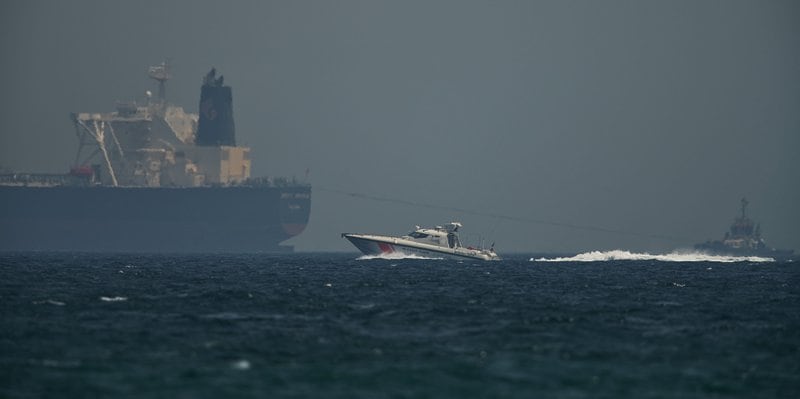U.S. Central Command raised the threat level in Iraq and Syria on Tuesday, rebuking comments from a top British general that Iranian-backed fighters do not pose an increased risk to coalition forces fighting the Islamic State.
“There’s been no increased threat from Iranian-backed forces in Iraq and Syria," British Army Maj. Gen. Christopher Ghika, a deputy commander with the Operation Inherent Resolve coalition, said Tuesday during a video briefing from Iraq.
Ghika added that the measures in place to protect U.S. and coalition forces were “completely satisfactorily,” and said that the coalition’s leadership does not “intend to change them."
In the hours following Ghika’s press briefing, CENTCOM announced that the threat level was increased.
“Recent comments from OIR’s Deputy Commander run counter to the identified credible threats available to intelligence from U.S. and allies regarding Iranian-backed forces in the region," said Capt. Bill Urban, CENTCOM’s lead spokesman.
“U.S. Central Command, in coordination with Operation Inherent Resolve, has increased the force posture level for all service members assigned to OIR in Iraq and Syria," Urban added. “OIR is now at a high level of alert as we continue to closely monitor credible and possibly imminent threats to U.S. forces in Iraq.”
The comments from the international coalition’s deputy commander were at odds with warnings from the White House and the Pentagon over the past week used to justify a military build-up in the region.
Some worry the U.S. is unnecessarily ratcheting up tensions as part of a pressure campaign against Iran that also involves economic sanctions.

The warnings were followed by the deployment of a B-52 bomber task force, one Patriot missile defense battery and an amphibious transport dock to the region. An aircraft carrier strike group was also ordered to the region early, skipping a port of call in Croatia.
“Am I concerned about the danger: no, not really," Ghika said of the alleged Iranian threats. "We take a range of force protection measures for operating in this part of the world against a whole range of threats, and we review them regularly. We’ve reviewed them, obviously, in light of the events in the last week or so.”
Ghika said that his assessment was not at odds with that of the U.S. government.
“I don’t think there’s a difference here at all," Ghika said, adding that Inherent Resolve is not operating against Iran and that he would only speak to the threat of Iranian-backed militias. "I’m not going to go into the detail of it, but there are a substantial number of militia groups in Iraq and Syria and we don’t see any increased threat from any of them at this stage.”
RELATED

There are a wide range of militias that sprung up during the fight against the Islamic State in Iraq, known as the Popular Mobilization Forces, or PMF. A number of Shia militias were sponsored by Iran. After ISIS’ physical caliphate was largely eliminated, some militias were brought into the fold of Iraqi security forces, but some were not.
In a Pentagon inspector general report this month, U.S. Central Command said that Iranian-aligned forces are focused on supporting the Syrian regime’s fight against ISIS and are not displaying the intent to attack U.S. forces.
“However, USCENTCOM reported to the DoD OIG that this calculus could change if Iran perceives a U.S. desire to ramp up anti-Iranian activities in a post-ISIS environment,” the report reads.
Ghika’s comments also come on the same day that the New York Times reported that the Pentagon presented a military plan to the president’s top national security aides that calls for up to 120,000 troops deploying to the Middle East and a potential cyber-attack on Iran’s infrastructure should Iran speed up its nuclear program or attack U.S. forces.
The president dismissed the report as he was leaving the White House Tuesday.
“I think it’s fake news, OK?” he told reporters, adding that those plans have not been drawn up. "Hopefully, we’re not going to have to plan for that. If we did that, we would send a hell of a lot more troops than that.”
Secretary of State Mike Pompeo flew to Iraq last week to underscore its need to protect U.S. forces in the country against the alleged increase in Iranian threats.
“We talked to them about the importance of Iraq ensuring that it’s able to adequately protect Americans in their country,” Pompeo said. “We wanted to let them to know about the increased threat stream that we had seen and give them a little bit more background on that, so they would have enough information that they could ensure that they were doing all that they could to provide protection for our team.”
Kyle Rempfer was an editor and reporter who has covered combat operations, criminal cases, foreign military assistance and training accidents. Before entering journalism, Kyle served in U.S. Air Force Special Tactics and deployed in 2014 to Paktika Province, Afghanistan, and Baghdad, Iraq.





